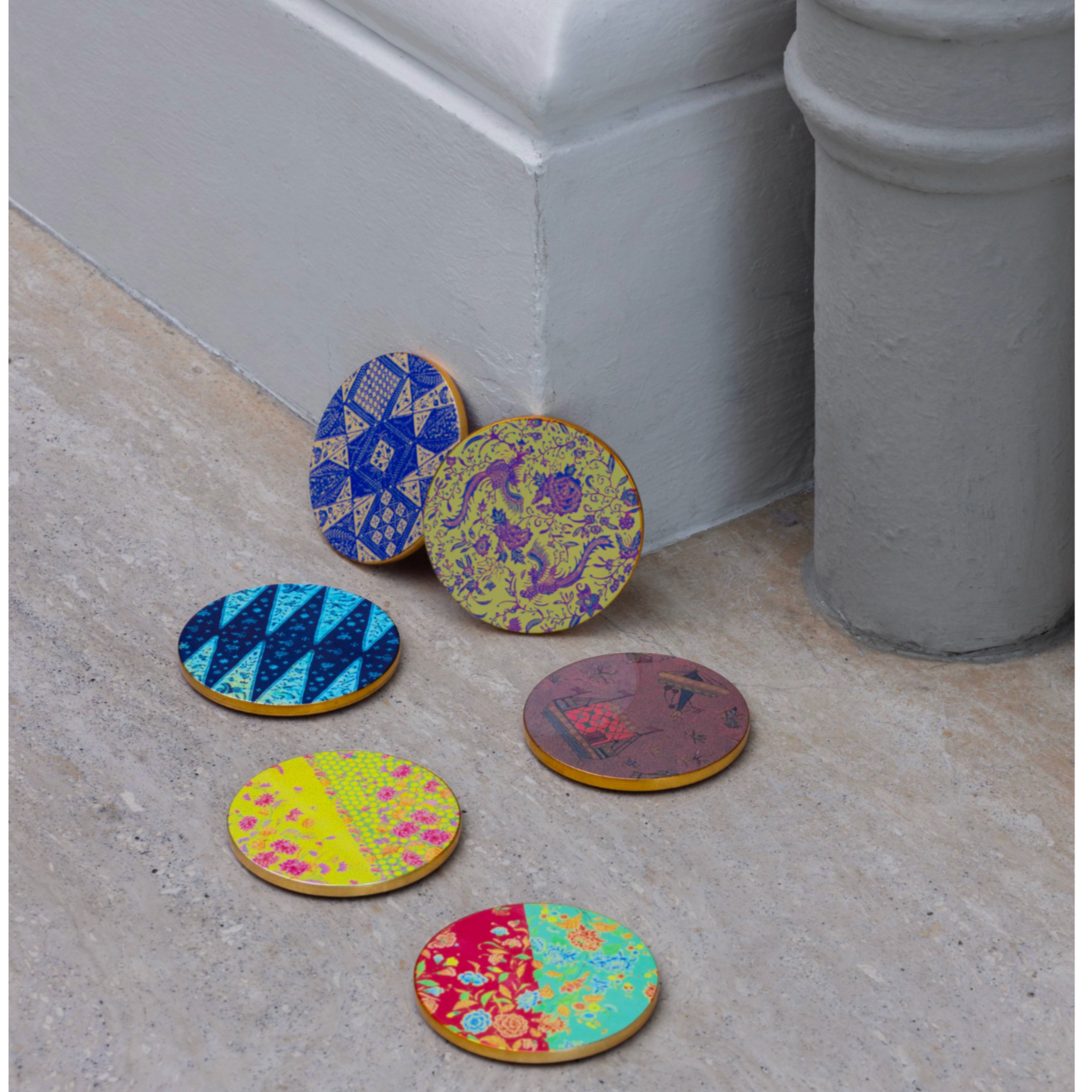NATIONAL COLLECTION X MUSEUM MARTKET LACQUER COASTER SET OF 6
$125.00 SGD
– Sold OutBEDSPREAD (KAIN SPREI)
Indonesia, early 20th century
Cotton (drawn batik)
Collection of Peranakan Museum
2014-00951
The ambi (tear-drop shape) and Tree of life motifs on this textile reveal connections to Indian cloths traded to Southeast Asia from the 13th century onward. Auspicious Chinese symbols like phoenixes, peonies and butterflies point to the role they played in Peranakan wedding celebrations.
SARONG
Java, Cirebon, 1900-10
Cotton (drawn batik)
Collection of Peranakan Museum
2015-02114
This colour combination of blue and white batik sarong is known as kelengan. The front panel of the sarong is decorated with triangle patterns known as tumpal, with birds like chickens and phoenixes filling the background of the cloth. Along the borders of the tumpal-filled section of the sarong are fret patterns, a decorative feature commonly found on Chinese ceramics and furniture.
Batik sarongs were worn by Peranakan Chinese in the Strait Settlements and Indonesia as a skirt to accompany a top known as kebaya.
SKIRT CLOTH (KAIN PANJANG) THE TIE SIET
Java, Pekalongan, 1930s
Cotton (drawn batik)
Collection of Peranakan Museum
2018-00647
This pink-and-aqua batik kain panjang (skirtcloth) features the pagi-sore (morning-afternoon) format, where two different patterns and colours are divided by a diagonal or straight line at the center. The wearer could choose which side of the design to be visible according to the time of day and occasion. The batik is signed " The Tiet Siet Pekalongan " by the famed Peranakan Pekalongan-based batik-maker. This piece illustrates his characteristic use of bold colours and floral bouquets (peonies and chrysanthemums on each side, respectively), with birds and butterflies flying around them. Peonies are associated with female beauty, and chrysathemums are associated with longevity and nobility. Peranakan ladies favoured batik skirtcloths made mostly by Chinese and Eurasian batik-makers on the northern coast of Java in towns such as Cirebon, Lasem, and Pekalongan.
SARONG
Java, 1900-20
Cotton (drawn batik)
Collection of Peranakan Museum
2015-02120
This colour combination of blue and white batik sarong is known as kelengan. The body of the sarong is decorated by large lotus buds while the front panel is decorated by patch-work designs, known as tambal motifs.
Batik sarongs were worn by Peranakan Chinese in the Straits Settlements and Indonesia as a skirt to accompany a top known as a kebaya.
BATIK SKIRTCLOTH WITH BIRDS, BOATS AND AEROPLANES MOTIFS
Pekalongan, northern coast of Java, 1960s
Textile
Collection of Asian Civilisations Museum
2010-03486
This sarong is in a style known as kompanie batik, one of the most unique batik styles developed in Indonesia in the early nineteenth century, during the Dutch colonial period. The patterns and motifs blended Indonesian and European visual sensibilities. Modern images of aeroplanes and ships are portrayed in a fantastical style alongside birds and fish.
SARONG, OEY KOK SING
(NEE KHO TJING NIO), 1896-1966
Java, Pekalongan,1940
Cotton (drawn batik), synthetic dyes
Collection of Peranakanan Museum
2017-00341
Gift of Ika, Melia, and Inge Hendromartono in memory of their parents Liem Siok Hien and Jane Hendromartono, grandmother Mrs Oey Kok Sing, and grandmother Mrs Oey Soen King.
Oey Kok Sing was the daughter of Oey Soen King. She embraced the use of synthetic dyes, which were available in Java by the late 19th century.
Dimensions of each coaster: 10 x 10 x 0.6cm.


